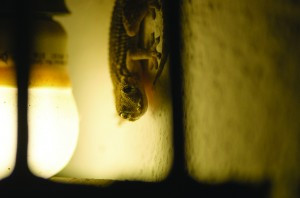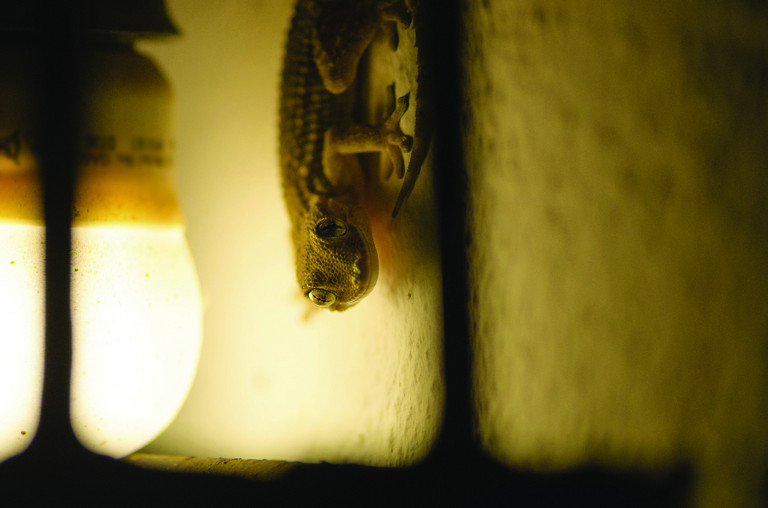Lighting the Way Forward for Reptile Retailers
Erik J. Martin //February 10, 2014//
When a good idea pops in your head, the proverbial light bulb goes off. Judging by the number of inventive and eye-catching new reptile lighting and heating products that made their debut in the past several months, the year 2013 was a bright one for retailers who have been eager to offer patrons more and better options in this category.
Illuminating Introductions
Reptile owners enjoy gazing at their scaly critters in their caged environments. But, how often do they look through the eyes of a lizard to appreciate what the animal sees? Enter Exo Terra’s Reptile Vision bulbs, which produce the correct visual light output that reptiles’ eyes are sensitive to.
“Reptiles communicate visually and physically, but for years we’ve always placed them under lights that were visually pleasing to us,” Steve Sotelo, division manager for Exo Terra in Mansfield, Mass., said. “The Reptile Vision bulb improves perception and stimulates breeding and appetite by offering a pleasing light spectrum.”
Another notable improvement observed in recent months is bulbs that have been tweaked to output stronger intensity UVB and UVA light, such as Zoo Med’s Reptisun T5 bulb. This bulb is just right for larger and taller tanks because they offer UVB penetration at longer distances and are available in 5.0 and 10.0 configurations and in 22 inch, 34 inch and 46 inch lengths. The manufacturer has also introduced a new Reptisun High Output T5 low profile fixture compatible with the new bulbs and available in 24 inch, 36 inch and 48 inch sizes.
Lights that help make a herp habitat smell better is not the stuff of science-fiction; it’s already here via Exo Terra’s new Natural Light Ion deodorizing compact fluorescent light. This bulb’s built-in ionozer helps reduce or eliminate harmful airborne particles that cause odors.
Cutting Through the Clutter
Choosing the correct reptile lighting and heating elements can be tricky sometimes with so many options available to consumers today, said Ashley Rademacher, animal care and education coordinator for Zoo Med Labs, Inc. in San Luis Obispo, Calif.
The solution? Value-added bundles.
“Combination packages offered nowadays make it easier for customers, especially newcomers, to choose the products they need,” Rademacher said.
Zoo Med’s Reptisun mini compact fluorescent UVB lamps come standard in several different lighting packages that each offers a mini deep dome lamp fixture and a spot, UVB and/or basking lamp. Case in point, the Desert UVB and Heat Lighting Kit combines a mini combo deep dome, basking spot lamp and a 10.0 mini-CFL UVB lamp, while the Aquatic Turtle Lighting Combo bundles a mini deep dome and a Turtle Tuff splash-proof halogen basking lamp.
Another way to make shopping simpler is to roll out all-in-one light and heat sources. Exo Terra’s Sunray uses metal halide technology to produce such a solution — combining UVA, UVB, infrared heat, the aforementioned Reptile Vision feature and a light bracket in one product.
“New lighting and heating products that combine several features into one showcase well because the shopper can see that the cage has fewer wires and bulky fixtures attached to it,” Misia Shumway, manager for Austin Exotic Pets in Austin, Texas, said. “It also makes for a cleaner, simpler look that merchandises well.”
To help consumers make a more educated, but easier choice, manufacturers are also providing user-friendly apps designed to find the ideal lighting/heating product. Exo Terra recently launched its UVB Buddy app for iPhone and Android, and Zoo Med’s Mobile App for Android provides quick access to its various products.
Warming Up to Innovation
Ask your share of pet retailers how satisfied they’ve been with the latest reptile lighting/heating merchandise, and you’ll likely get positive responses.
“Today’s heating and lighting products are manufactured to a higher quality than in years past and are offered in greater varieties and packaged better to get the shopper’s attention,” Shumway said.
Bruce Delles, owner of Twin Cities Reptiles, Inc. in St. Paul, Minn., agrees that the push lately has been toward energy savings and compact design, as evidenced by the influx of high-output bulbs available in smaller sizes as well as LED lights. While the latter doesn’t offer UVB/UVA benefits, they are ideal for species like snakes that don’t require ultraviolet.
“These LED bulbs are very small and more streamlined, and they can save big money on electricity,” Delles said.
Modern mini halogen bulbs are also competing well with their fluorescent competitors and large domes as primary heat and UVB sources for many herps, he said.
“Thanks to these more compact light designs, retailers can save more space in their stores, especially with vertically stacked setups,” Delles said. “I can now fit 5 tanks on my vertical shelving where I could only fit four previously, thanks to these smaller light fixtures replacing standard fluorescent aquarium hoods.”
Smaller lighting and heating elements also mean greater visibility for prospective purchasers, who can now see more of the habitat and its occupants when they visit the store.
Getting On the Same Page
Colorful new SKUs energize owners, but sales goals can backfire unless you train your employees to talk to customers about the latest heating and lighting products, Shumway says.
“Your shoppers have to be able to see the benefits in replacing their older fixtures with more energy efficient, space-saving ones on the market today,” Shumway said. “And that means training your staff and making sure they know how to upsell and promote the advantages of certain products over others, even if they are more expensive. If you can demonstrate to customers that they’ll save more money in the long run, they’ll take a closer look at those products.”



















